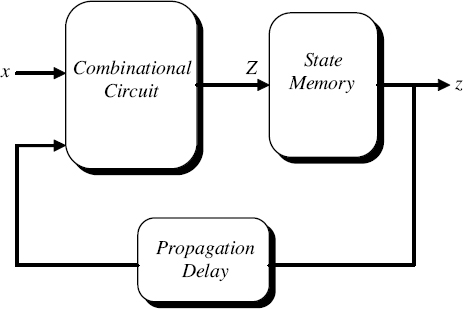9.11 ASYNCHRONOUS SEQUENTIAL CIRCUITS
Finite-state machines also include another class of sequential circuits, known as asynchronous sequential circuits. Asynchronous sequential circuits do not require a clock to function. The memory of the asynchronous sequential circuit may include flip-flops or time-delay devices. Whereas state transitions in a synchronous circuit are controlled by changes in the clock, asynchronous circuits depend on the time-delay propagation of the logic gates. The time-delay propagation, however, is not always consistent throughout the stages of the circuit. Thus, the feedback time delay may not be predictable. For this reason, asynchronous sequential circuits have limited applications. A typical application of asynchronous sequential circuits is where a circuit must respond to an input change promptly rather than waiting for a change in the clock. Consider the asynchronous sequential circuit in Figure 9.57. Its state is represented by the expression

Figure 9.57 Structure of an Asynchronous Sequential Circuit
![]()
where Z is the next state, z is the present state, and x is the input of the circuit. The propagation time delay consists of the feedback loop in the circuit.
For example, consider the case where the input changes from 0 to 1 and causes the next state ...
Get Introduction to Digital Systems: Modeling, Synthesis, and Simulation Using VHDL now with the O’Reilly learning platform.
O’Reilly members experience books, live events, courses curated by job role, and more from O’Reilly and nearly 200 top publishers.

